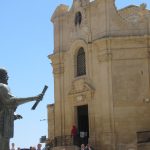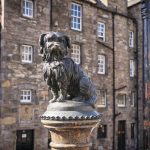World War II in Valletta, now there’s a subject you will keep coming across as you tour the city. This post begins with a little history from the period and explains why the island of Malta was awarded the prestigious George Cross. Then we look at 3 museums which all take a different approach, covering the military action here on ‘Fortress Malta’ and also explaining what the war did to the daily lives of its people. We end with a look at some of Valletta’s memorials to this turbulent period, which are all within a few minutes’ walk of each other at the Floriana end of the city.
world War II in Valletta


On June 10th, 1940, Italy joined the war on the German side and the very next day the first bombs were dropped on Malta. Things looked bad. Malta had so few planes that the three Gloster Gladiators which played a heroic role were given individual names – Faith, Hope and Charity. German bombing began in 1941 and things got much worse. Particularly bad examples include January 10th when a British Aircraft Carrier bringing much-needed supplies was hit with the loss of 126 crew and January 16th when St Lawrence Church in Vittoriosa took a direct hit and 35 people who had taken refuge in its crypt, mainly women and children, were killed.
1942 was, say the history books, ‘without doubt, the worst year of the war’ and Malta was said to be the most heavily bombed place on earth. In April alone 6,727 tons of bombs were dropped on the island. Over 500 people were killed that month and the Royal Opera House in Republic Street took a direct hit and was more or less destroyed. Malta’s strategic position made holding out vital and on April 15th came a message of recognition and gratitude from King George VI: ‘To honour her brave people I award the George Cross to the island of Fortress Malta to bear witness to a heroism and devotion that will long be famous in history.’
In July 1943, Mussolini was removed from power and in September that year Italy surrendered to the Allies. Malta, say historians, ‘could breathe again.’
the national war museum


This museum, part of the Fort St Elmo complex, covers all periods of Maltese history from the Bronze Age to the island gaining its independence in 1964, and it is particularly good on the Great Siege of 1565 and on World War II. It tells the story of the latter through information boards, photographs and a vast collection of memorabilia. Highlights include Roosevelt’s jeep, one of the island’s three plucky little gladiator planes – Faith – and, of course, the original George Cross and its accompanying citation
the malta at war museum


This is in Vittoriosa (aka Birgu), one of the Three Cities, which can easily be reached by boat from Valletta. It’s focussed on daily life on the island during World War Two and the ground floor is a museum where you can learn many details on, for example, blackouts, air raids, bomb disposal work, rationing and food shortages. Below the museum is a labyrinthine underground shelter which you can walk round. You will see some of the communal dormitories, along with areas such as the birthing room and the air raid warden’s office, all of which gives a vivid idea of the life many Maltese lived in underground shelters, often for weeks or even months at a time.
A graphic picture emerges of the deprivation suffered. There were shortages of everything: food, water and fuel especially. To combat the black market, Victory Kitchens were set up, so food could be collected and shared out to everyone. One meal per day was served to each person who had bought a ration ticket and the portions were meagre. One day, a sardine and some haricot beans, another a small portion of vegetable soup. As one local put it, ‘When rabbit stew was served, one did not ask what had become of the cat’. People recall fetching water from pumps in the street and queuing endlessly for petrol, which often ran out before they reached the end of the line.
the lascaris war rooms


This underground complex in Valletta was the HQ for British Forces on Malta during World War II. Its endless corridors, offices and huge map rooms have been left as they were and guides will explain how 240 people per shift worked down there, taking radio information from pilots and plotting the ever-changing situation with wooden counters on giant maps so that their commanders could take decisions about what action to take. Numerous displays explain such varied topics as the types of fighter planes and flying formations which were used, and how reconnaissance missions and air-sea rescue missions were organised.
The book Ladies of Lascaris by Paul McDonald recounts the true story of Christina Ratcliffe, who came to Valletta as a cabaret dancer and was then recruited to work as an aircraft plotter in the Lascaris War Rooms. It’s a gripping story, telling much about the operations conducted here and introducing a range of real people who served. As the author explains, ‘What took place there was one of the best kept secrets of World War II in Malta. The secure, but dark and sunless rooms became the nerve centre of Malta’s defence.’
three memorials


The National War Memorial comprises an obelisk, an eternal flame, a Maltese flag and a carved citation from George V, so referencing World War One, but just as pertinent in a World War Two context: ‘Let me assure you that I am fully conscious of the important and patriotic part that Malta has played during these years of warfare.’ King George V, 3.11.1918
The Commonwealth Air Forces Memorial, a towering column with a golden eagle on top, is engraved with the Royal and Commonwealth Air Forces motto, ‘Per Ardua ad Astra’, or ‘Through adversity to the Stars’ and a list of 2,300 names of pilots from many UK and commonwealth countries. The inscription explains: ‘Over these neighbouring lands and seas, the airmen whose names are recorded here fell in raid or sortie and have no known grave.’
The ruins of the Royal Opera House in Republic Street have been re-designed as an open-air concert venue, a permanent reminder of the damage wrought by World War II bombs.
Listen to the podcast
reading suggestions
Fortress Island Malta by Peter Jacobs
Ladies of Lascaris by Paul McDonald
Churchill and Malta’s War by Douglas Austin
links for this post
National War Museum
Malta at War Museum
Lascaris War Rooms
Previous episode Finding the Knights of Malta in Valletta
Next episode Art, Architecture and Archaeology in Valletta
Last Updated on February 17, 2025 by Marian Jones





